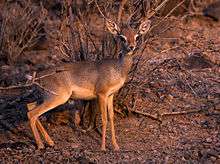Salt's dik-dik
| Salt's dik-dik | |
|---|---|
 | |
| ' | |
| Scientific classification | |
| Kingdom: | Animalia |
| Phylum: | Chordata |
| Class: | Mammalia |
| Order: | Artiodactyla |
| Family: | Bovidae |
| Genus: | Madoqua |
| Species: | M. saltiana |
| Binomial name | |
| Madoqua saltiana Desmarest, 1816 | |
The Salt's dik-dik (Madoqua saltiana) is a small antelope found in semidesert, bushland and thickets in the Horn of Africa, but marginally also in northern Kenya and eastern Sudan.[1] It is named after Henry Salt who discovered it in Abyssinia in the early 19th century.[2][3]
Description
Salt's dik-dik are 52–67 cm (20–26 in) long, 33–41 cm (13–16 in) high and weigh 2.5–4.0 kg (5.5–8.8 lb).[4] As in other dik-diks, the small, pointed horns are only present in the male.[5] The colour varies significantly depending on the subspecies.
Taxonomy
Together with the closely related silver dik-dik, this species forms the subgenus Madoqua in the genus Madoqua (other dik-diks are also in the genus Madoqua, but the subsgenus Rhynchotragus).[6][7] The taxonomy of this subgenus is complex and a matter of dispute. Today, the most widely used treatment is based on a review in 1978,[8][9] but a significantly different treatment was presented in a review in 1972.[6] Following the review in 1978, the silver dik-dik is treated as a separate monotypic species, and the Salt's dik-dik has five subspecies:[4][9]
- M. s. saltiana: Found from northern Ethiopia to Eritrea and far eastern Sudan, it is relatively large with a reddish-grey back.
- M. s. hararensis: Found in the Hararghe region in eastern Ethiopia, it has a gingery back and dark red flanks.
- M. s. lawrenci: Found in eastern and southeastern Somalia, it has a silvery back and russet flanks.
- M. s. phillipsi: Found in northern Somalia, its back is grey and the flanks are orange.
- M. s. swaynei: Found in the Jubba Valley region of southern Ethiopia, southern Somalia and far northern Kenya, its back is brown-grey.
In 2003, each of the above was proposed to represent an evolutionary species,[10] but at present, most maintain them as subspecies.[1][9] The review in 1972 differed significantly from the above. Under that treatment, three species are recognized in the subgenus Madoqua: Salt's sik-dik (M. saltiana with the subspecies saltiana and cordeauxi), Phillip's dik-dik (M. phillipsi with the subspecies phillipsi, gubanensis, hararensis and lawrencei) and Swayne's dik-dik (M. swaynei with the subspecies swaynei, erlangeri and piancentinii).[6] Of these taxa, cordeauxi, gubanensis and erlangeri were considered entirely invalid in 1978.[8]
Behavior
Salt's dik-dik are shy animals. They are active at night and dusk to avoid the midday heat, and are considered crepuscular. Dominant dik-dik flare their crests. The animals are most often found in pairs and small groups, and Salt's dik-dik mainly eat leaves and shoots of acacia trees. Not much is known about the species' reproduction behavior.
References
- 1 2 3 Heckel, J.-O.; Wilhelmi, F.; Kaariye, X.Y.; Rayaleh, H.A. & Amir, O.G. (2008). "Madoqua saltiana". IUCN Red List of Threatened Species. Version 2008. International Union for Conservation of Nature. Retrieved 29 March 2009. Database entry includes a brief justification of why this species is of least concern.
- ↑ http://www.scirecordbook.org/salt-dik-dik/
- ↑ http://www.abebooks.com/servlet/BookDetailsPL?bi=9217116097&searchurl=xpod%3Don%26podrfn%3Don%26bx%3Don%26tn%3Dlife+correspondence+henry+salt+consul+general+egypt%26kn%3Dlife+correspondence+henry+salt+consul+general+egypt+NOT+%28%22print+on+demand%22+OR+%22printed+on+demand%22%29
- 1 2 Kingdon, J. (1997). The Kingdon Guide to African Mammals. Academic Press. ISBN 0-12-408355-2
- ↑ Haltenorth, T., and H. Diller (1980). Mammals of Africa Including Madagascar. HarperCollins. ISBN 0 00 219778 2
- 1 2 3 Ansell, W. F. H. (1972). Order Artiodactyla. Part 15. Pp. 1-84. in: Meester, J., and H. W. Setzer, eds (1972). The mammals of Africa: An identification manualSmithsonian Institution Press, Washington, D.C.
- ↑ Wilson, D.E.; Reeder, D.M., eds. (2005). Mammal Species of the World: A Taxonomic and Geographic Reference (3rd ed.). Johns Hopkins University Press. ISBN 978-0-8018-8221-0. OCLC 62265494.
- 1 2 Yalden, D. (1978). A revision of the dik-diks of the subgenus Madoqua (Madoqua). Monitore Zoologico Italiano, n.s. suppl. 11: 245-264.
- 1 2 3 Wilson, D.E.; Reeder, D.M., eds. (2005). Mammal Species of the World: A Taxonomic and Geographic Reference (3rd ed.). Johns Hopkins University Press. ISBN 978-0-8018-8221-0. OCLC 62265494.
- ↑ Cotterill, F. P. D. 2003. Species concepts and the real diversity of antelopes. in: Plowman, A., eds (2003). Proceedings of the Ecology and Conservation of Mini-antelope: An International Symposium on Duiker and Dwarf Antelope in Africa. Filander Verlag: Füürth. pp. 59-118.
